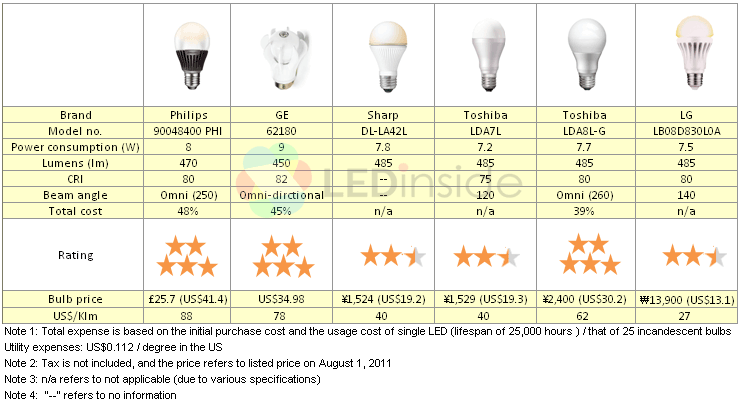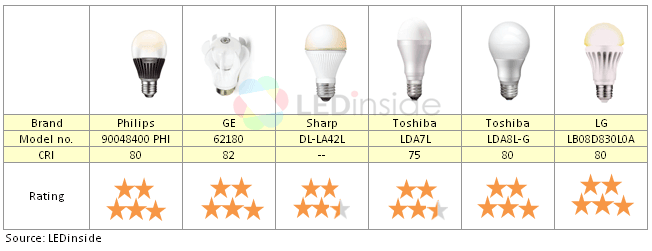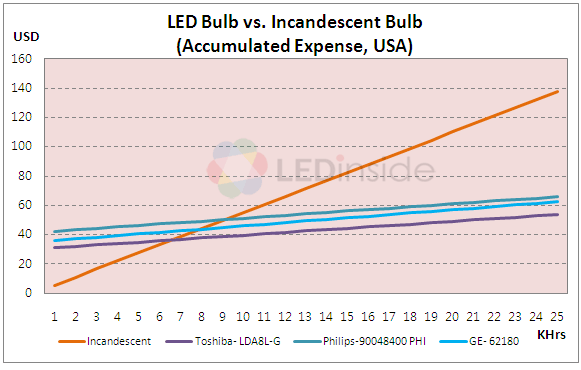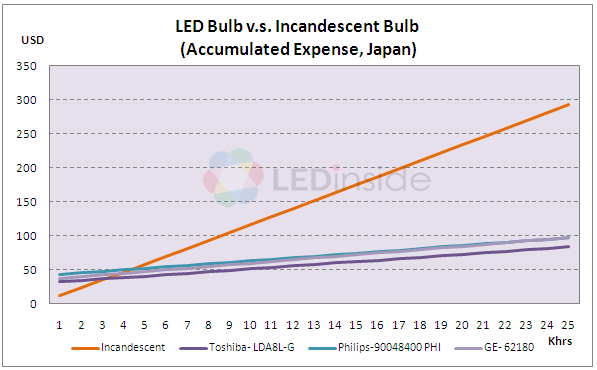LEDinside: Are LEDs Really a Suitable Replacement for 40W Incandescent Bulbs? A Look at Cost-Performance Ratio
In consideration of whether or not LED light bulbs are truly a proper replacement for 40W incandescent bulbs, as major manufacturers claim, brightness is an important factor, as LEDinside has previously mentioned. What other standards must be met in order to make the transition to LED bulbs?
According to a previous survey on brightness of LED light bulbs by LEDinside, a research division of TrendForce, major brands that lived up to replacement specifications include European company Philips, U.S. lighting giant GE, Japanese manufacturers Sharp and Toshiba, and Korean electronics maker LG. While these companies’ products meet brightness standards, do they also adhere to other standards necessary for incandescent light bulb replacement?
LEDinside further analyzes light bulbs from major international LED makers that met brightness standards to replace 40W incandescent lamp.

Color Rendering Index
First, in terms of color rendering, the CRI of LED lighting is not as high as that of incandescent bulbs (CRI = 100). Both the U.S. Department of Energy (DOE) and Korea’s Korean Industrial Standards (KS) have CRI standards for the replacement of incandescent bulbs with LEDs. The DOE requires a CRI of 80 or above, while the KS standard is 70 CRI or higher. While LED products from the major brands do not match incandescent bulbs in terms of CRI, they still meet various national standards. Uniquely, Sharp does not list CRI values for their products. While LEDinside believes Sharp’s products have ratings of 70 CRI or above, it is somewhat disappointing that they do not explicitly label their products as such.

Beam Angle
Beam angle, or light distribution, is another important standard in LED lighting. Unlike CRI, product specifications vary quite a bit by manufacturers: beam angles begin at 120 degrees and range to more than double that, at 260 degrees. Looking at things from an incandescent lamp standpoint, most LED products are not up to par as the light distribution of incandescent bulbs is general and non-directional, with a beam angle of over 300 degrees. As LED light bulbs are inherently directional, a different standard is required for measuring LED beam angle.
At present the U.S. DOE and JELMA (Japan Electric Lamp Manufacturers Association) are both working on new standards for LED light bulbs replacing incandescent bulbs. Bulbs that meet current national standards include: GE’s 62180, Philips’ 90048400 PHI (250 degrees), and Toshiba’s LDA8L-G (260 degrees). These products are a cut above the rest due to their adherence to beam angle standards.

Cost-Performance Ratio
After sifting through various LED products, a few winners have emerged. However, the products that met required specifications for replacement of 40W incandescent bulbs also have accordingly high prices.
Taking a step back to look at the total economic benefit analysis, the lifespan of a single incandescent bulb is 1,000 hours. At 3 hours of use per day, one bulb will last one year (3 hours x 365 days ≈ 1,000 hours), with total expense at approximately US$5.50 (initial purchase price plus cost of electricity). All of the previously mentioned LED bulbs, while boasting low power consumption, have a higher initial purchase price than their incandescent lamp counterparts.
However, such an analysis is unfair to LED bulbs that each has a lifespan of 25,000 hours. Looking at it from a different angle, the lifespan of a single LED bulb is equal to that of twenty-five 40W incandescent bulbs. Thus, it is clear that whether we are looking at GE’s 9W 62180, Philips’ 8W 90048400 PHI, or Toshiba’s 7.7W LDA8L-G. Besides, the total expense (initial purchase price plus cost of electricity) for one LED bulb is approximately 40% ~50% lower than that of 25 40W incandescent bulbs (based on U.S. electricity rates).

Since electricity rates vary by country, total accumulated expense will vary as well. In countries with higher electric prices such as Japan, total expense for one LED bulb is only 30% or so less than that of 25 incandescent bulbs. In other words, once a consumer has bought four incandescent bulbs, their total cost has exceeded that the LED equivalent.

LEDinside Summary
While many manufacturers claim that their LED light bulbs are suitable substitutes for 40W incandescent bulbs, in actuality there are few products that meet replacement standards. As for those that pass the test, although initial cost is much higher than incandescent lamp purchases, factoring in longer lifespan and higher efficiency, LED bulbs still come out on top in regards to cost-performance ratio.
Still, as LED light bulb inspection standards are not fully developed, LED product specifications are not yet uniform. Different LED manufacturers place emphasis on different product features, causing consumers much confusion in the purchase of LED lighting. The fog will only clear when governments set clear standards and LED makers automatically disclose full product information. Until then, LEDinside will strive to objectively survey and present findings on LED products and their main specifications, in order to provide consumers with a comprehensive resource to refer to when making the decision to purchase LED light bulbs.





 CN
TW
EN
CN
TW
EN










